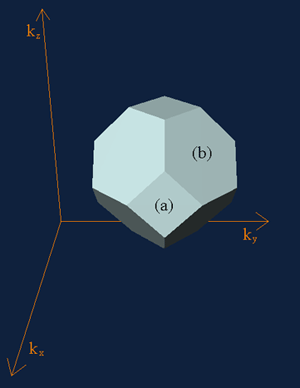Questions
Quick questions
You should be able to answer these questions without too much difficulty after studying this TLP. If not, then you should go through it again!
-
If a real space vector has length L, what is the magnitude of the corresponding reciprocal lattice vector as defined in this TLP?
-
Which of the following statements about the Brillouin zones for a particular reciprocal lattice are correct? (select yes for true and no for false for each statement)
Deeper questions
The following questions require some thought and reaching the answer may require you to think beyond the contents of this TLP.
-
By either printing out the lattice in the file linked to here (pdf), or by drawing out a rectangular lattice with the ratio between the short and long sides of 4:5. Use the method outlined earlier to construct the first three Brillouin zones, being careful not to miss any relevant Bragg planes.
-
By either printing out the lattice in the file linked to here (pdf), or by drawing out a parallelogram lattice with the ratio between the short and long sides of 4:5 and an angle between the sides of about 75 degrees. Use the method outlined earlier to construct the first three Brillouin zones, being careful not to miss an relevant Bragg planes.
-
Confirm that when expressed in a Cartesian basis, possible lattice vectors of the primitive unit cell (i.e., the unit cell with one lattice point per unit cell) for a FCC lattice of unit side length are
 ,
,  and
and  .
. -
Confirm that when expressed in a Cartesian basis, possible lattice vectors of the primitive unit cell for a BCC lattice of unit side length are
 ,
,  and
and  .
. -
Using the definition of the reciprocal lattice basis vectors given in the TLP, show that the reciprocal lattice of a FCC lattice is a BCC lattice and vice versa.
-
For a conventional BCC unit cell with two lattice points per unit cell of side L:
- How many nearest neighbours does each point have?
- What are their coordinates, and what distance away are they?
- How many next nearest neighbours are there?
- What are their coordinates and what distance away are they?
-
Look at the picture below of the first Brillouin zone for a real space FCC lattice. Using your answers to questions 5 and 6, try to index the planes labelled (a) and (b).


